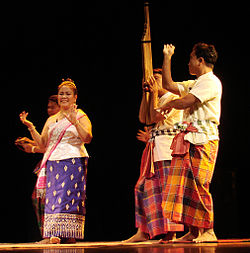Culture of Laos
Anthropologists consider the Lao Loum as a subcategory of the wider “Tai” ethnic group who share common genetic, linguistic, and cultural heritage.The Lao Loum occupy the Mekong River valleys and cultivate wet rice crops, they are predominantly Theravada Buddhist but have strong syncretism with traditional animist beliefs.Also included in the Lao Theung population are Katang, Bru, Kui, Laven, Mal, Phai, Katu, Lave, Ngae, Jeh, Khuen, Jeng, Alak, Ir, Kasseng, Khlor, Aheu, Bo, Halang, Doan, Hung, Xinh Mul, Khua, Arem, Bit, Chut, Maleng and Mlabri.Other groups of Lao Sung include the Akha, Kaw, Lahu, Kaduo, Lisu, Hani, Phana, Si La, and Kado.The shrine has been rebuilt several times since being created in the thirteenth century by the Khmer, with the largest expansions by King Setthathirath in the 1500s as part of a nationwide building campaign.Traditionally in Laos males would become novice monks at some point in their lives, giving them the opportunity to gain both an education and religious merit (boun).Astrology was a vital part to understanding the natural and spiritual worlds and became an important cultural means to enforce social taboos and customs.Traditionally the Lao Loum also believed that ancient mythical serpents known as ngueak inhabited major waterways, carving out the surrounding countryside and protecting key points along rivers or other bodies of water.Lao social status places an emphasis on respect for elders; religious images and clergy; family and village authority; and the Buddhist concept of dharma which emphasizes personal moral duty.The baci reinforces the soul and the community, and involves all the gathered into making prayers and well-wishes symbolized by silk or cotton threads which are tied around the wrists.The story recalls the past life of a compassionate prince, Vessantara, who gives away everything he owns, including his children, thereby displaying the virtue of perfect charity.As a consequence much of the traditional art and architecture in Laos has been pillaged, stolen, sold, destroyed or suffered significant damage over the past three centuries.Central Laos runs along the Mekong River and is known for natural indigo dyes and diamond patterns which symbolize the protective scales of the mythical naga.Ironically the Phra Souk or “Lucky Buddha,” sank in the Mekong during the storm which occurred when the three images were being moved by the Thais, the legend is depicted in murals at the Wat Pho Chai.Many were sold or taken as souvenirs, a number of royal images were lost in 1910 when the French gunboat the La Grandiere sank on the Mekong en route to a Paris exhibition.Traditionally Lao use intricately woven bamboo mats in homes and temples, although much of the art form has been lost due to the availability and durability of plastic substitutes.According to legend, the first peace agreement between Fa Ngum and the Dai Viet established that Lao lands began where the rivers and streams feed the Mekong and the people live in houses built on stilts.Lao architecture experienced a Golden Age during the sixteenth and seventeenth centuries when many buildings of cultural significance were sponsored by Kings Visoun, Photisarath, and Setthathirath.Lao stupas also have a distinct character, with That Luang being the most recognizable example, but would also include the That Phanom in Isan, Thailand, That Dam in Vientiane, and That Sikhottabong (That Ing Hang) in Thakhek.The lam vong begins with an individual using head and hand movements based on Buddhist mudras, who is then joined by a partner, and then by other couples until a crowd forms with three interconnected and slowly turning circles.The film portrays in graphic detail the difficulties of bomb removal in Laos, including the dangers faced by the poor population who dig the scrap metal for resale.Among men, the Lao traditionally wear a Khmer style billowed trouser or sampot, a Mandarin collar jacket or Indochinese shirt, and a simple pha biang or checkered shawl.Men and women wear religious amulets, and large amounts of gold and silver jewelry which is believed to ward off evil and is a conspicuous sign of wealth.Lao Sung groups including the Hmong, Yao and Akha are known for elaborate embroidery, extensive silver ornamentation, and intricate color based patterns.Men typically wear black pants tied with an embroidered band, a French inspired Indochinese shirt, and a colorful headband.Insects can be eaten in a variety of forms, with the more pungent types being used as spices or substitutes, such as common red fire ants for lemon-like sourness in southern soups.The years of French colonialism have also given Laos a number of food items including the baguette or khao jii, as well as omelets, pâté and croissants.The common Lao breakfast reflects French influence and is a simple affair of strong coffee served hot or iced, and is taken with a baguette or other pastry which dipped in condensed milk.Ka-taw or kick-volleyball is also a traditional Lao sport, where players use a rattan ball and advance play using their feet, knees, chest and head.Laos hosts over twenty national parks, with hiking, biking, whitewater rafting, canoeing, kayaking, caving, rappelling and zip-lining being increasingly common activities.




















Luang PrabangMekong RiverWat PhuSoutheast AsiaLao LoumIndic culturesThailandCambodiaAnnamite RangeVietnamChineseSinitic cultureKingdom of Lan XangSipsong PannaSipsong Chau TaiKhorat PlateauList of ethnic groups in LaosLao TheungLao Sunghill tribesVietnameseTai DamTai DaengTai KhaoThai IsanLao TaiThaificationTheravada BuddhistsyncretismanimistMon-Khmer peoplesKatangTaoistUnited StatesFranceslash-and-burnLao languagemonosyllabicTai-KadaiVientianegeopolitical historySainyabuliPhongsaliLuang Nam ThaUdomxaiXiang KhoangHoua PhanKhammuanBolikhamsaiChampasakSalavanSavannakhetAttapeuSekongBangkok ThailexicongrammarAsymmetric intelligibilityAustro-Asiatic languagesMon-KhmerHmong-MienBurmo-TibetanFrenchEnglishReligion in Laosethnicsatsana phiChristianityBuddhism in LaosTheravada BuddhismThat Luanglotus blossomBuddhaKing Setthathirathspirit houseAstrologytaboosBuddhismLan Xangsecularsanghanobilitycaste rulesTheravadaKing of LaosholidaysdharmaBuddhistLao peoplecognatesAñjali MudrāLiterature of LaosWat Maitraditional literatureSin XayRocket FestivalKhun BoromPhra Lak Phra LamRamayanaJatakafolkloreLao artcommunistÉcole française d'Extrême-Orient (EFEO)Prince Phetsarathnationalist movementnon-governmental organizationsHaw Phra KaewRoyal Palace MuseumLao silkindigoLao Buddhist Sculpturemotifsmudrasaquiline nosesPhra BangLuang Pra BangCeylonKhmer EmpireFa Ngum'sWat ManoromWat SisaketPhra KaewGrand PalaceBangkokpalladium
